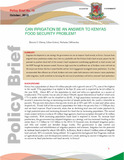| dc.contributor.author | Otieno, Dennis | |
| dc.contributor.author | Kirimi, L. | |
| dc.contributor.author | Odhiambo, N. | |
| dc.date.accessioned | 2021-07-06T14:03:44Z | |
| dc.date.available | 2021-07-06T14:03:44Z | |
| dc.date.issued | 2015-10 | |
| dc.identifier.citation | Policy brief 19Affiliation: Tegemeo Institute of Agricultural Policy and Development. DOI:10.13140/RG.2.2.28740.55681 | en_US |
| dc.identifier.uri | https://www.researchgate.net/publication/351359389_CAN_IRRIGATION_BE_AN_ANSWER_TO_KENYAS_FOOD_SECURITY_PROBLEM | |
| dc.identifier.uri | https://www.tegemeo.org/images/_tegemeo_institute/downloads/publications/policy_briefs/policy_brief19.pdf | |
| dc.identifier.uri | http://hdl.handle.net/123456789/4713 | |
| dc.description.abstract | Irrigation development is one strategy the government can use to improve food security in Kenya. Lessons from irrigated maize production studies show that it is profitable and that Galana Kulalu food security project has the potential to produce about half of the country’s food requirement contributing significantly to food security and the GDP through the incomes earned. However, high costs due to inefficient use of fertilizer, water and land are the major cost factors that have caused doubts and low level engagement in irrigated maize production. It is thus recommended that efficient use of land, fertilizer and water under both intensive and extensive maize production under irrigation, would contribute to lowering the unit cost of production and lead to increased food production. | en_US |
| dc.language.iso | en | en_US |
| dc.title | Can irrigation be an answer to Kenya’s food security problem? | en_US |
| dc.type | Technical Report | en_US |

